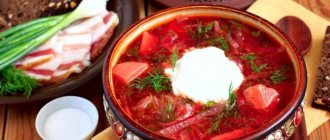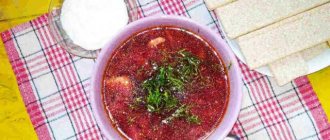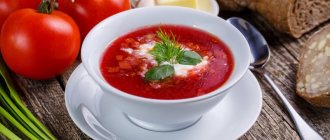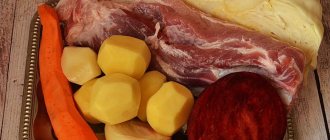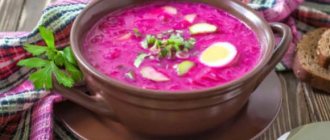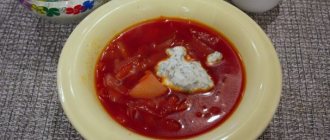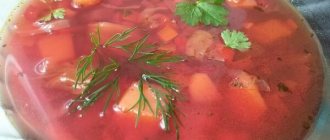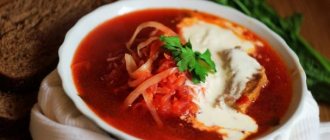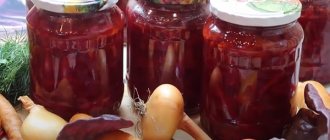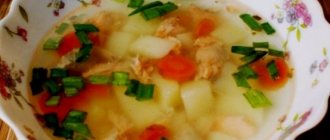Borscht is a dish of Ukrainian cuisine, but it is also popular among many other nations. There are different recipes for making this cabbage and beet soup. The most unusual option is Moscow borscht. It is prepared from several types of meat and sausages, which is why it is a bit reminiscent of a meat hodgepodge. However, the taste and color are characteristic of traditional borscht. The soup got its name because its recipe often included sausages, which were difficult to purchase outside the capital. Today this product is available to residents of any region, and every housewife can cook Moscow borscht in her kitchen.
Cooking features
The recipe for Moscow borscht includes a significant number of ingredients, so it may seem complicated at first glance. In fact, even an inexperienced cook can master the process. The main thing is not to violate the technology of preparing this unusual first course.
- When cooking, it is important to give Moscow borscht the rich red color characteristic of this category of soups. To do this, use tomato paste (or fresh tomatoes) and beets. If it becomes discolored, the dish will take on an unappetizing dirty burgundy hue. To prevent the color from boiling out, beets are added to the soup already prepared and no more than 10 minutes before the pan of borscht is removed from the stove. Treating the vegetable with lemon juice or vinegar also helps preserve the rich hue of the vegetable.
- When cooking borscht, it is important to follow the correct sequence of ingredients. Potatoes are placed in the boiling broth, 5 minutes after it, fresh cabbage is added, followed by boiled meat and sausages, after which fried vegetables are dipped into the soup, and greens are added last. After adding the last ingredient, the soup is allowed to boil for a few minutes, otherwise it will quickly spoil.
- Borscht will not be appetizing if the broth for it is not cooked correctly. Be sure to remove the foam that appears on the surface when cooking meat, do not let the broth boil too much, and then it will come out transparent.
- The aesthetics of the dish is also affected by the accuracy of cutting vegetables and other ingredients. Grind them as indicated in the recipe, do not make the pieces too large or shapeless.
- The taste of Moscow borscht greatly depends on the quality of meat and sausages. There is no need to save money when choosing these products.
- If you let the borscht brew for 24 hours, it will taste better. If you want to taste it the same day, keep it covered for at least 20-30 minutes after cooking.
Simple cooking
- Fill the beef (veal) and smoked pork ribs (can be replaced with other smoked meats) with water and cook the broth (this will take from an hour to two). We filter the finished semi-finished product, and we disassemble the caught meat, separating it from the bones - it will go back into the dish - you can return it immediately to the broth.
- Cut the carrots with onions and fry them in vegetable oil. When the carrots begin to turn golden, add tomato paste and simmer a little more.
- Cut the washed and peeled beets into thin strips and lightly simmer in oil. Add a little broth, vinegar with sugar, tomato and simmer until the product softens. At the end of the stew, add the fried roots, carrots and onions, and simmer for another ten minutes.
- Shred the cabbage into small pieces, put it in the broth and cook for about ten minutes along with the potatoes. Add the stewed dressing and cook for the same amount of time. Finally, add the spices, turn off the heat and let it brew for half an hour under the lid.
- “Moscow” borscht (recipe with photo in front of you) is ready to eat – you can put it on the table!
Borsch "Moskovskiy" with ham and sausages
Compound:
- beef on the bone – 0.5 kg;
- ham – 100 g;
- sausages – 100 g;
- beets – 100 g;
- carrots – 100 g;
- onions – 100 g;
- white cabbage – 100 g;
- butter – 40 g;
- tomato paste – 40 ml;
- sugar - a pinch;
- apple cider vinegar (6 percent) – 5 ml;
- water – 2.5 l;
- salt, spices - to taste.
Cooking method:
- Wash the beef, cover with water, and place over medium heat.
- Wash the cabbage and remove the top leaves. Chop the vegetable into small strips.
- Scrub the carrots, wash and dry. Cut into strips or chop using a Korean salad grater.
- Peel the beets and cut into short, thin strips.
- Remove the skin from the onion. Cut the onion into thin quarter rings.
- When the water in the pan with meat boils, remove the foam. Reduce heat and close the lid, leaving a gap. Cook for 1-1.5 hours until the meat comes off the bones easily. 10–20 minutes before readiness, salt the broth to taste, add pepper, bay leaf, and other spices.
- Remove the finished meat from the pan, cool, and cut into cubes about 1 cm in size.
- Cut the ham into strips, sausages into slices.
- Strain the broth and place on the stove. When it boils, add cabbage to it.
- Melt the butter in a frying pan, add onions and carrots. Fry them until golden brown, reduce heat.
- Place the beets in the pan and fry them along with other vegetables for 5 minutes.
- Pour in vinegar, sprinkle with sugar, stir. After 2-3 minutes, add tomato paste and simmer the vegetables with it for 5 minutes.
- 15 minutes after adding the cabbage, add meat, ham and sausages to the borscht. After 5 minutes, add the vegetable frying.
- Cook the soup for another 5-10 minutes, remove from heat.
- Leave the pan on the stove, covered, for another half hour.
Ingredients:
- Pork – 400 grams
- Sausages – 2 pieces
- Potatoes - 2-3 pieces
- Carrots – 1 piece
- Onion – 1 piece
- White cabbage – 300 grams
- Tomato - 2-3 pieces
- Beetroot - 1 tbsp. spoon (medium)
- Sunflower oil - 20 Milliliters
- Bay leaf – 1 piece
- Garlic – 1-2 cloves
- Salt - To taste
- Sugar - 1 teaspoon
- Vinegar 9% – 1 teaspoon
- Parsley – 10 Grams
Number of servings: 6
Moscow borscht with smoked meats
Compound:
- boiled beef – 120 g;
- smoked ham – 80 g;
- sausages – 150 g;
- lard – 100 g;
- white cabbage – 0.25 kg;
- carrots – 150 g;
- celery root – 100 g;
- onions – 150 g;
- broth - 2 l;
- lemon juice – 20 ml;
- butter – 50 g;
- tomato paste – 40 ml;
- beets – 0.2 kg;
- sugar – 5 g;
- salt, spices - to taste;
- sour cream, herbs - for serving.
Cooking method:
- Cut the beef into small cubes, the bacon and smoked ham into strips, and the sausages into slices.
- Peel the cabbage from the top leaves, wash and chop.
- Cut the peeled carrots and beets into thin strips.
- Peel the celery root and cut into small cubes.
- Finely chop the peeled onion.
- Fry the bacon in one frying pan, melt the butter in another.
- Fry the onion and celery root in butter for 5 minutes. Add tomato paste to them, sauté until it turns orange.
- When the bacon in another frying pan has melted, add carrots and beets and fry them for 5 minutes.
- Add sugar and lemon juice and continue frying for the same amount.
- Pour a ladle of broth into the pan with carrots and beets. Simmer the vegetables until soft.
- Boil the broth. Put cabbage in it. Cook for 15 minutes.
- Add meat products.
- When the soup boils again, add the roasted roots to it.
- After the next boil of the soup, add carrots and beets.
- Cook for 10 minutes, then turn off the burner and leave the borscht covered for 20 minutes.
- Pour into plates, season with sour cream, sprinkle with chopped herbs and serve.
A little history
In Russian cooking, the recipe for Moskovsky borscht, as many researchers believe, has Ukrainian roots, and it has taken root well in our conditions, so to speak, developing and acquiring more and more new components. And today, few people can refuse a plate of aromatic and tasty, hot first course. By the way, disputes over the origin of the dish itself - borscht - have been going on for centuries. According to one hypothesis, borscht was first prepared in Kievan Rus. And over time he became very popular, he was loved not only by ordinary people, but also by representatives of the elite. For example, Catherine the Second called borscht her “favorite food” and even kept a special cook at her court to prepare the dish.
However, priority in the birthplace of borscht is attributed to such nations as Polish, Moldavian, Lithuanian. According to historians, at first these thick soups were prepared using beet kvass - it was diluted with water, then brought to a boil. After cooking in the oven, seasoned with herbs and salt. Such traditions are preserved today in Polish and Belarusian cuisines. It is also worth mentioning borscht - a labor-intensive dish to prepare. Classic borscht “Moscow” (the recipe for its preparation is given below) is made in several stages, and cooking takes several hours. The dish will also require special processing, for example, of the same vegetables: beets are stewed separately, and onions and carrots are used for special frying or dressing, as the housewives call it. This kind of borscht is mentioned in many works of classic literature; Bulgakov and Mayakovsky, and many others treated it to the heroes of their works. Well, are you ready for some culinary action?
Classic cold borscht recipe
An unusual name for borscht, isn't it? However, the list of products is also not quite ordinary... So, we will need:
- boiled beets – 1 pc.;
- boiled potatoes – 2 pcs.;
- boiled egg – 1 pc.;
- fresh cucumber – 1 pc.;
- green onions and dill - to taste;
- kefir – 250 ml;
- mineral water – 250 ml;
- salt - to taste.
Preparation:
- We grate all the vegetables on a coarse grater, chop the green onions and dill with a knife. Mix everything in a deep bowl.
- Pour equal amounts of kefir and mineral water into a bowl, add salt, mix everything thoroughly and the cold borscht is ready.
- All that remains is to pour it into plates and garnish with parsley leaves.
About variations
Speaking of additional ingredients. They should not fundamentally change the taste of this authentic dish. That is, roughly speaking, instead of borscht you should not get, for example, beetroot soup or some other first course. Lemon is one of the most popular additives. If you add lemon, remove the vinegar from the ingredients. Some people also like to add fresh tomatoes to the borscht. Or add prunes. Everything is possible, but without going overboard, so as not to drown out the main bouquet of taste and aroma.
Description of preparation:
Borscht is perhaps one of the most popular first courses in our latitudes. It is filling and tasty. Considering that borscht contains a considerable amount of vegetables, its benefits are not even worth talking about. It is easy to prepare, but you still need to have some cooking skills. And they also say: “One hundred housewives - one hundred borscht.” Each one has its own. So do I. I am not a supporter of very fatty, rich borscht. And I prefer to basically boil all the ingredients rather than fry them. Some people simmer onions, carrots and beets in a frying pan with plenty of broth. Essentially, these vegetables are cooked in a frying pan. So what's the difference between cooking them in broth or in a frying pan? Therefore, my entire cooking process takes place in a saucepan. They suggest simmering for another 40 minutes. What vitamins can we already talk about? Therefore, we prepare the borscht as quickly as possible and serve it to the table. Instead of tomato paste, it is better to put chopped tomatoes in the borscht. In my opinion, it tastes much better this way. Cook borscht using any meat broth. I have pork. Not counting the time for preparing the broth, I spend 40-45 minutes on borscht.
Purpose: For lunch Main ingredient: Meat / Pork / Offal / Sausages Dish: Soups / Borscht
History of borscht
There is no reliable written evidence of when and where borscht appeared in its modern form. There are several options for its origin.
According to one version, back in the middle of the 16th century in Rus' there was a kind of vegetable-herbal-bottling soup, which was the prototype of the current borscht. It could contain nettles, onions, garlic.
Indeed, in “Domostroy” (16th century) there is advice to plant borscht (an edible plant similar to large dill) and harvest it in the autumn.
In 1816, a collection of recipes by Levshin V. “Russian Cookery” was published. There are recipes for borscht with beef, ham and chicken.
Avdeev E.A. and Maslova N.N. The Cookbook (1912) already published several recipes for borscht.
Borsch is registered in the cuisines of both Russia and Ukraine. But it is still believed that ordinary borscht comes from Ukraine. Ukrainian borscht was once prepared with beet kvass, which was added as an acidifier. They added carrots and cabbage to it and simmered it in ovens. Previously, it was unthinkable without lard.
Later (from about 1920–1930), they began to add potatoes, beans, and tomatoes (tomato paste) to the evolving borscht.
In the famous “Book of Tasty and Healthy Food,” which was first published in 1935, a couple of pages are filled with borscht recipes.
In the general Soviet cuisine, various names for borscht arose:
- Ukrainian;
- Moscow (beef with the addition of smoked meats and ham);
- summer
Nowadays, such a first course is eaten in different parts of the world, since the Slavs, when they leave, take their culinary traditions with them.


